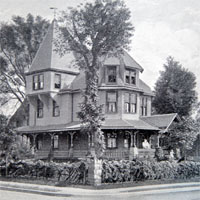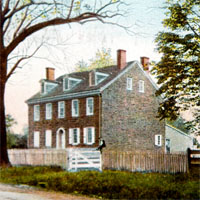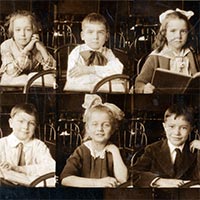"Haverford av., looking east from Forrest av., was a country lane in 1875." Narberth's main street as a muddy horsecart track appeared in a Philadelphia Evening Bulletin story of June 24, 1951, "Narberth — Its Residents Call It 'Best Darn Town in the World'".
Haverford Avenue was indeed a country lane in 1875. Since the 1680s, as Haverford and Merion Road, it connected the Merion Meeting House to the Haveford Meeting house. Its route followed what is today E. Wynnewood Rd., Old Wynnewood Rd. and Eagle Road. Only Montgomery Avenue, then "the Lancaster Road", pre-dates it.
But this image cannot date from 1875. The print has been doctored to obscure details: examine the cart's seat, the telegraph pole, the background behind the boy, and the left side of the street. This was presumably to reduce clutter for newsprint, but possibly to enhance the "rural" effect.
The remaining details prove the photo must date between 1897 and 1907, probably the earlier end of the range. Despite its rough handling, we can identify and date several structures.

The one-story frame building in front of the cart stood for less than a dozen years. It appears in the 1900 property atlas, but not in 1896 or 1908 editions. You can see it in Downtown from the tracks, also dated to about 1898.
The taller roofline behind it is 246 Haverford Ave., still standing today, home to the GET Cafe.
This was a temporary chapel built after the 1896 fire that consumed the Narberth Presbyterian church. After the current church was erected in September 1897, it was moved to this location.
Is this building in the photo? It was the office for the coal yard (in 2023, with a later second story, "Revivals") between buildings 1 and 2 and the trestle. It first appears in the 1900 atlas, so if it's not here, the photo is 1898–99.
What would we have seen in 1875?
Surely no sidewalks. On the left, the driveway to Maria Furey's farmhouse "ran through quite a beautiful grove, … following a course similar to Forest avenue." (Carden Warner, 1905) To the right, the railroad was a two-track line. There was no rail siding, no bridge over the tracks, and no buildings on William Thomas's farm between the street and tracks, save for the newly built Elm Station behind us. "Boater" hats that became so popular from the 1890s through the 1920s, seem out of place in a farm community only 10 years after the Civil War, the year before the Centennial.
Updated June 22, 2023.










































































